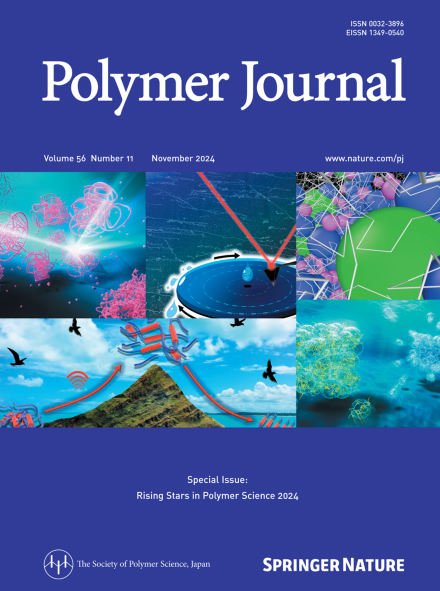Molecular dynamics simulations of the mechanical properties of dissociative dynamic bond elastomers with different binding-site sequences
IF 2.7
4区 化学
Q3 POLYMER SCIENCE
引用次数: 0
Abstract
Dynamic bond elastomers are attracting attention because of their self-healing properties and toughness. However, understanding the factors that influence their mechanical properties remains challenging because their unique crosslinking structures lead to properties that are not well explained by classical rubber elasticity theory. This study utilized coarse-grained molecular dynamics simulations to investigate the effects of the one-dimensional sequence of binding sites and reaction time prior to elongation on the mechanical properties of dissociative dynamic bond elastomers. Uniaxial elongation simulations of systems with random and regular sequences revealed the existence of kinetically and thermodynamically controlled crosslinking structures depending on the reaction time. Notably, elastomers with a regular sequence and shorter reaction time displayed a higher modulus, which was attributed to an increased ratio of interchain crosslinks to total crosslinks. These findings offer novel insights into the structural determinants of the mechanical behavior of dynamic bond elastomers. Dynamic bond elastomers are attracting attention because of their self-healing properties and toughness. Using coarse-grained molecular dynamics simulations, we studied how the sequence of binding sites and reaction time before elongation affect their mechanical properties. Our simulations with random, regular, and semiregular sequences indicated that reaction time influences the formation of crosslinking structures. Elastomers with a regular sequence and shorter reaction time had a higher modulus due to more interchain crosslinks. These findings provide new insights into the mechanical behavior of dynamic bond elastomers.

具有不同结合位点序列的离析动态键弹性体力学性能的分子动力学模拟
动态键合弹性体因其自愈性能和韧性而备受关注。然而,了解影响其机械性能的因素仍然具有挑战性,因为其独特的交联结构导致经典橡胶弹性理论无法很好地解释其性能。本研究利用粗粒度分子动力学模拟研究了一维结合位点序列和延伸前反应时间对解离动态键弹性体力学性能的影响。随机和规则序列体系的单轴延伸模拟表明,存在随反应时间变化的动力学和热力学控制的交联结构。值得注意的是,具有规则序列和较短反应时间的弹性体显示出更高的模量,这归因于链间交联与总交联的比例增加。这些发现为动态键弹性体力学行为的结构决定因素提供了新的见解。动态键合弹性体因其自愈性能和韧性而备受关注。通过粗粒度的分子动力学模拟,我们研究了延伸前的结合位点序列和反应时间对其力学性能的影响。我们对随机、规则和半规则序列的模拟表明,反应时间影响交联结构的形成。具有规则序列和较短反应时间的弹性体由于更多的链间交联而具有较高的模量。这些发现为动态键合弹性体的力学行为提供了新的见解。
本文章由计算机程序翻译,如有差异,请以英文原文为准。
求助全文
约1分钟内获得全文
求助全文
来源期刊

Polymer Journal
化学-高分子科学
CiteScore
5.60
自引率
7.10%
发文量
131
审稿时长
2.5 months
期刊介绍:
Polymer Journal promotes research from all aspects of polymer science from anywhere in the world and aims to provide an integrated platform for scientific communication that assists the advancement of polymer science and related fields. The journal publishes Original Articles, Notes, Short Communications and Reviews.
Subject areas and topics of particular interest within the journal''s scope include, but are not limited to, those listed below:
Polymer synthesis and reactions
Polymer structures
Physical properties of polymers
Polymer surface and interfaces
Functional polymers
Supramolecular polymers
Self-assembled materials
Biopolymers and bio-related polymer materials
Polymer engineering.
 求助内容:
求助内容: 应助结果提醒方式:
应助结果提醒方式:


